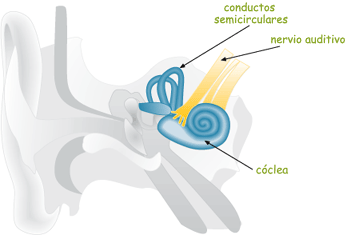Otitis
|
Inner ear
The inner ear is a very hard bony structure,covered by a membrane full of fluids which, when they move, stimulate the nerve cells.

It consists of two receiver units, which work differently:
- The cochlea, which governs hearing
- The sistema vestibular, which governs balance.
So, after the sound waves have entered the external ear and been turned into vibrations in the middle ear, the inner ear gets to work.
The vibrations reach the cochlea, a small spiral tube forming part of the inner ear and which is full of fluid. When the vibrations touch it, the fluid starts to vibrate, stimulating the nerve endings and creating an electrical impulse which travels along the auditory nerve to the part of the brain that translates it into sound.
The brain would never be able to recognise what reaches it - in this case, sound - if all the parts of the ear were not working in unison.
Just above the cochlea are the semicircular canals,which also contain fluid and thousands of tiny, microscopic cell endings. These canals are responsible for us keeping our balance.
For example, if you bend down, the fluid in the semicircular canals moves and in turn makes the cell endings move, thereby relaying a message to the brain regarding the position of your head. In less than a second, the brain knows what position your head is in and which muscles it has to inform so that you won't lose your balance and fall over.
